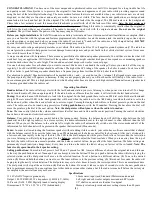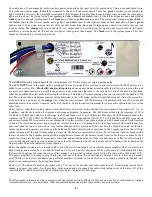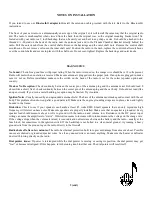
CONGRATULATIONS!
You have one of the most unique and sophisticated radios ever built! It is designed for a long trouble free life
and quality sound. Our objective is to preserve the original fit, functions and appearance of your radio while providing superior sound
using the best of the latest digital technology. The more modern features that were not available when your vehicle was new are cleverly
disguised so that they are functional and easily accessible, but are not visible. The face, knobs and pushbuttons are designed and
manufactured to look and feel just like the original. The AM dial scale looks like the original. The FM dial scale is in the background.
Please take a few minutes to read this manual and familiarize yourself with all of the features of this radio.
Note: The dial pointer and
pushbuttons are electrically operated and will not function without power.
Although this radio is considerably smaller than the original, it
will fit in the dash without any alterations. The radio is designed to work well with the original antenna.
Do not use the original
speakers.
They will not handle the power or the frequency range of this radio.
Before you begin installation:
Be Safe! Disconnect one battery terminal and leave it disconnected until installation is complete. Make
sure you are familiar with the options and features programmed into this radio. Locate the antenna jack, the auxiliary input, line outputs
and other options you may need before you mount the radio. If you want to “bench test” the radio use a fully charged battery.
DO NOT
operate this radio directly from a battery charger. Serious damage may result!
Be sure your radio voltage and polarity matches your vehicle. This radio is built for 12 volt negative ground systems only! The radio has
several protection circuits to help prevent serious damage from wiring errors and power faults in the vehicle electrical system. Never use a
fuse rated for more than 10 Amps!
A major consideration will be speakers. There are many possibilities for additional speaker placements. You will have to decide what will
work best for your application. Will it matter if the speakers show? You might consider kick panel, door speakers, or mounting speakers
under the dash where they’re out of sight. You can add an external amp or sub woofer (see next page).
Use one 4 ohm speaker for each channel you want to connect. Make sure it can handle the wattage! Unless you crank it all the way up
regularly, 30 or 40 watt RMS ratings should be sufficient. The higher the SPL rating of the speaker, the better it sounds. Look for an SPL
of 88 or better. A good full range speaker should have a frequency range from less than 40 Hz to better than 20 kHz.
Pay attention to polarity! Speaker terminals will be marked with a + and - , or a red dot on the + terminal. If all speakers are connected to
the proper polarity, they will operate in harmony. If they are not properly phased, you will not hear the full fidelity of the radio. Note: -
does not mean ground! This is a high power radio in which both speaker lines are driven with high currents!
Never
allow any speaker lead
to become grounded when the radio is on!
Operating Your Radio
Band selection:
The radio will always start with the last band and station you were listening to when power was turned off. To change
bands, turn the radio off, then on again quickly. If the radio has been off more than 5 seconds, it will start with the last band selected.
Tuning:
Your radio has an AM dial made to look like the original. In the background there is also an FM dial scale. Both are illuminated
at night. There is a small LED in the background that will be red when the radio is set to the AM band, green when the radio is set to the
FM band, and yellow when the receiver locks on to a stereo signal. Turning the tuning knob will move the dial pointer up or down the dial
scale. The radio can also be tuned using presets (see
Setting pushbuttons
) or with the Wonderbar. Pressing the bar above the dial will
move the pointer up the dial to the next station.
Note: the dial pointer will only move when the radio is turned on.
Tone:
The tone control (behind the volume control) provides flat bass and treble near the center position. Turning the control clockwise
boosts bass, and counter-clockwise boosts treble.
Balance:
Your radio has a balance control behind the tuning control. Turning the balance knob will shift the audio between the left
speaker(s) and the right speaker(s). In a stereo system, the audio information sent to the right channel is often different than the left
channel. When you set the balance to the extreme left or right, the radio will automatically switch out of the stereo mode and all of the
information for both channels will be present in the speaker that is selected (Mono mode).
Fader:
In order to allow adjusting the front/rear speakers without adding visible controls, your radio has a software control that is shared
with the balance control. To access the fader, tune to an FM station and set the balance control for the best sound. After you’ve listened for
a few seconds, tune rapidly to the top of the dial. The LED in the dial background will begin to flash. After a few seconds, the last station
you were listening to will start playing again. Use the
balance
control to adjust the front/rear fader. When you tune away from the top of
the dial, the radio will resume normal operation, and the balance control will no longer affect the fader function. The fader settings are
permanently stored (until you change them). Every time you turn on the radio, the fader values you last set will be re-loaded.
Note: The
fader is only operational in the 4 speaker setting.
Setting pushbuttons:
Your radio has 5 presets for FM, and 5 presets for AM. A major difference between the original radio and this one
is the way the pushbuttons are set.
Never
pull out or attempt to turn the buttons! When you push a button, the radio will start playing the
selected station, and the dial pointer will move to the selected location. To set a button to a different station:
(1)
Tune in the desired
station.
(2)
Press and hold the button you want to set. The tuner will move to the previous setting.
(3)
After about 2 seconds, the radio will
begin playing the newly selected station. The dial pointer may cycle a few times to locate the correct position. This is a normal procedure.
The dial pointer will stop at the new station.
(4)
Release the button. Be aware it takes a couple of seconds to write the new pushbutton
data to permanent memory. You can continue to set other buttons or tune other stations, but if the radio is turned off before the write cycle
is completed, the new stations may not be saved.
Specifications
11-16 Volts DC Negative ground only
Output: 180 W. RMS (45 W x 4 speakers @ 4Ω 14.4 V, 1kHz)
10 Presets (5 AM, 5 FM) Digitally tuned w/analog display
Dimensions: 8.75” W x 2.55” H x 3” D (behind dash)
3.5mm stereo input jack, Standard (Motorola) antenna jack
Left, right and sub woofer outputs use standard RCA jacks
1/2” shafts on controls are identical to original
Memory retention (presets and user settings) more than 40 years
(1)






















